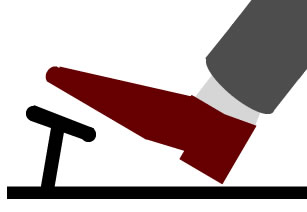The meaning cover the brake refers to a driver placing their right foot over the brake pedal but not touching the pedal.
By covering the brake, the driver is preparing to brake to a stop or slow down. Covering the brake is a technique taught by driving instructors to learner drivers at an early stage and the term is often extended to ‘cover the brake and clutch’ in manual cars.
By covering the brake and the clutch, a driver can naturally allow the car to slow down by removing their foot from the accelerator, slow down by applying the brake, or change to a lower gear.
Covering the brake is an important process of learning to drive. It is a process of identifying hazards and potential hazards and preparing the car for any such situation. As a learner driver there are many situations that you should cover the brake and often the clutch simultaneously.
You should cover the brake when
Approaching a certain stop such as a red light or traffic queue for example, a driver should cover the brake and clutch in good time. This will allow the car to naturally slow down before the need to initially press the brake followed by the clutch just before coming to a stop.

Covering the brake in good time such as these situations is an effective method for saving wear and tear on your vehicle and to also save fuel. By slowing down in good time by using this method, a traffic queue or red light can often change by the time you get there, allowing you to continue without the need to stop. Frequently moving a car off and stopping uses more energy and so more fuel and also causes more wear.
Covering the brake and clutch should be implemented just before taking left or right turns. This allows the car to slow down in good time as there is no need to brake harshly just before the turn. It is also much safer for vehicles who may be behind you. Approaching any form of junction or roundabout will often require a driver to cover the brake and clutch unless the junction is open and the driver can clearly see it is clear to proceed.
Hazards
Hazards come in the form of a variety of situations. Approaching a Zebra crossing that as a driver you do not have a clear view of both sides, may require you cover the brake and clutch in preparation to slow down. Any light controlled pedestrian crossing that has people waiting may change its lights as you approach. Approaching a cyclists ahead that you wish to overtake or a busy street with pedestrians.
Essentially, covering the brake (and clutch if not in automatic) reduces the time it takes you to slow down or stop and is therefore safer. As a learner driver, you must learn to identify any hazards or potential hazards in good time and use this covering technique.
Driving test manoeuvres
Driving test manoeuvres should be completed extremely slowly and can in many cars be completed by using the clutch alone without the need of the accelerator. If your car allows this, you can cover the brake whilst performing the manoeuvre. This makes the process of stopping much faster if the need arises.
When covering the brake and clutch
Hold your feet slightly above the pedals and try not to depress them. Simply covering the pedals and not depressing them often allows the car to sufficiently slow down. Even slightly pressing the brake or clutch when covering will cause wear on the brake pads and discs and also on the clutch plates. This could cause the brake and clutch to prematurely wear and need replacing.
Covering the brake general benefits
The “covering the brake” technique can be used effectively in the following situations:
- When driving next to parked cars – this allows for faster braking response if a person should walk into the road or if a car door opens for example
- When you see the brake lights of other cars – allows you to prepare the car for slowing or stopping in good time
- When approaching signal lights – when approaching light signals or other hazards such as Zebra crossings, this allows you to stop faster if necessary
Related braking tutorials
- The braking tutorial offers a guide on how to best use the cars brakes whilst learning to drive
- The engine braking guide explains how to use this technique
- The anti-lock brakes section goes into detail on exactly how ABS works
